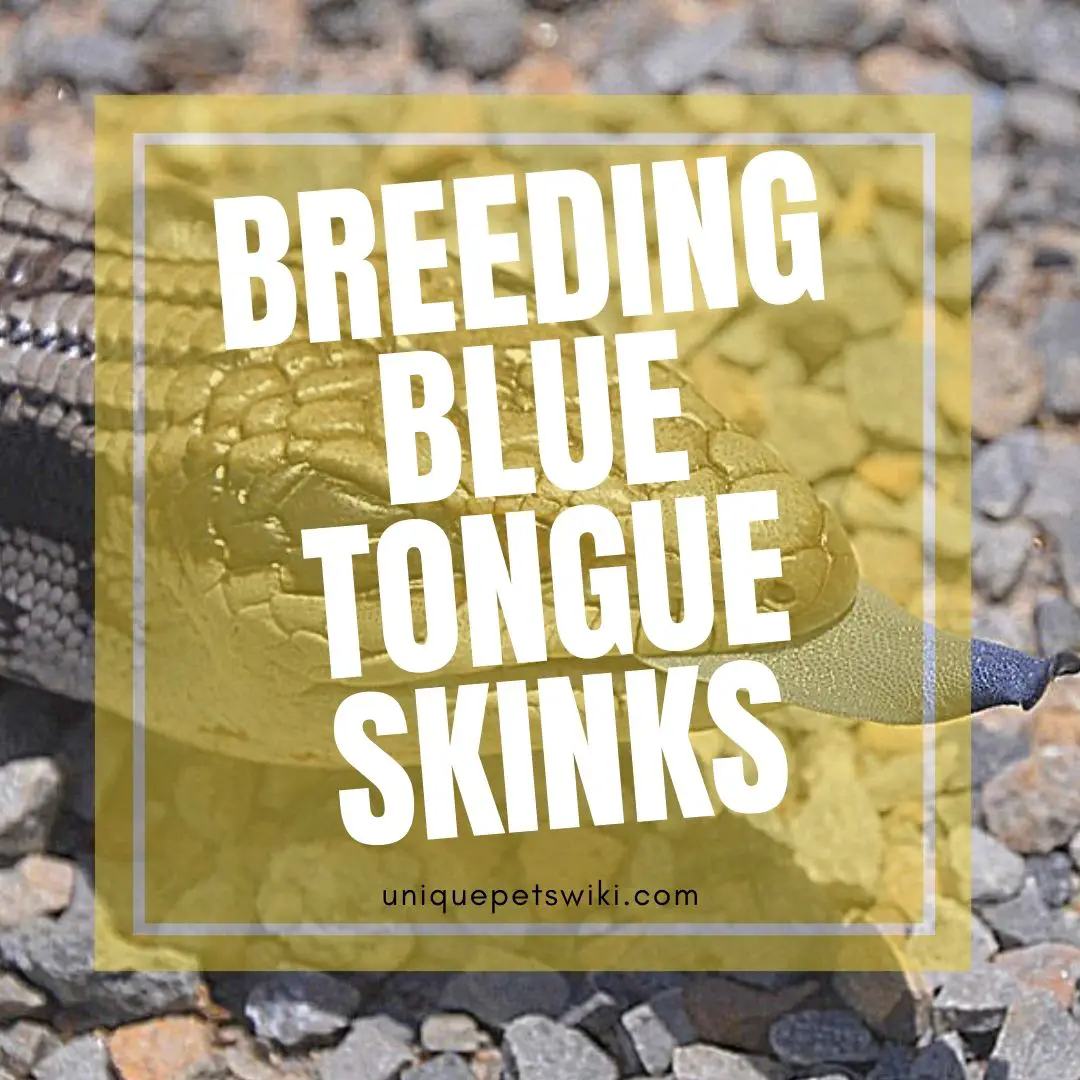Breeding blue tongue skinks only need to place a male and a female together? No, that’s not true. Breeding blue tongue skinks requires some technical knowledge.
In this article, we will tell you everything you need to know about blue tongue skink breeding.
Placing a male and female together can be fatal. Thus, keep reading through the article to understand what you need to know during and after breeding blue tongue skinks.
This article has been reviewed by Dr. Dilber. Read more about our knowledge control process here.
Contents
- What You Need to Know About Breeding Blue Tongue Skinks Upfront
- Can A Male And A Female Blue Tongue Skink Be Put Together?
- How Does Blue Tongue Skink Mating Behavior Look Like?
- How Old Does A Blue Skink Tongue Have To Be To Breed?
- How Many Babies Does A Blue Tongue Skink Have At One Time?
- Do Blue Tongue Skinks Have a Breeding Season?
- How to Breed Blue Tongue Skinks in Steps
- How Long after Mating Does a Blue Tongue Skink Give Births?
- Is my Female Blue Tongue Skink Laying Eggs?
- What to Remember When Taking Care of Baby Blue Tongue Skinks
- Conclusion
What You Need to Know About Breeding Blue Tongue Skinks Upfront
There’s a lot that goes on during blue tongue skink breeding. Thus, if you decide to breed your blue tongue skink, you should not take it lightly, nor should you be in a rush.
Therefore you should be willing to research and learn more before breeding your blue tongue skink. This article will educate you on the breeding process of a blue tongue skink.
However, it doesn’t mean that you should not research further. Even so, in this article, we will give you step by step guidelines on how to breed your blue tongue skink.
Let’s start!
Can A Male And A Female Blue Tongue Skink Be Put Together?
Not at all!
Here’s why:
- First, it is worth noting that blue tongue skinks are not social animals. Thus, housing them together is inadvisable.
- Secondly, it’s natural that all-male are sexually active throughout their lives. I mean, they produce semen all day long. Thus, if you house a male a female together, the male will keep trying to breed.
Mating blue tongue skinks when the female is not ready to breed can cause stress to both males and females. It is because; the female will be aggressive towards the male. On the other hand, the male will be causing stress to the female, trying to force it to mate.
Semen production in blue tongue skinks is controlled by reproductive hormones. Besides stimulating semen production, these hormones also cause changes in the behavior of males. That’s why males are aggressive while the mating and breeding seasons. The aggressive behavior of males can also irritate females which leads to stress.
In the wild, a female blue skink can escape a horny male blue tongue skink. But, in captivity, if the tank is small and there are no many hiding places, the only way for a female to escape mating is by fighting the male.
Also, blue tongue skinks are territorial animals who like to work independently. Therefore, they might even fight to the death if they feel like their space is limited.
It is wrong to house a male and a female blue tongue skink together unless it’s breeding season.
How Does Blue Tongue Skink Mating Behavior Look Like?
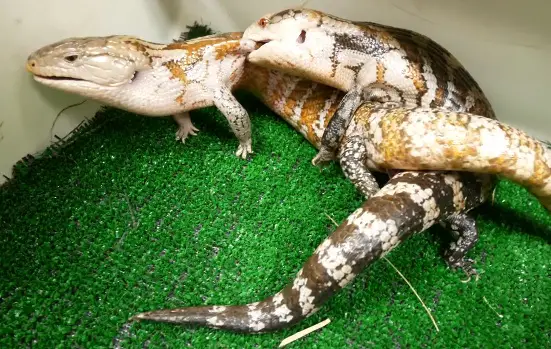
(Source: Brian Barczyk YouTube)
Blue tongue skinks when ready to mate, they will portray several vital behaviors. Watch out for the following reaction in your blue tongue skink.
Male Blue Tongue Skink Behavior
When it’s breeding season for blue tongue skinks, the male is the one that goes to search for the female. During this period, 95% of blue tongue skinks that die are males while crossing the road, searching for females.
The male will first test the female’s willingness to mate several times early in the mating season. The male approaches the female from the side or rear. At this time, the male walks with bumpy irregular movements, and his body rises above the ground.
At this time, he directs his tongue skims towards the female’s head, the body, and the cloaca. Then, he starts to chase her around the cage, trying to grip her on the torso with his mouth.
New to blue tongue skink? Check out the blue tongue skink care sheet now! We had listed out all the things you need to know about blue tongue skinks as pets. Check it now!
The male might have to try several times before succeeding to secure his grip on the resisting, violent female.
During the breeding season, males always keep walking in search of females, as females release scent and attract when they are in estrus. When male blue tongue skink finds a female, it starts moving around the female in circles to convince it to cooperate for mating. Males also try rubbing the skin of the females with their feet.
When the male succeeds to grip the female, he curls his body around her and positions his cloaca alongside his. He then takes advantage of the rigid female to tilt her body forcibly until she exposes her cloaca.
Sometimes the female breaks free at this point. But the male recaptures her and uses his hind feet to scratch her at the base of the tail. If the female responds positively, she raises her tail and opens cloaca for the male to insert the hemipenis.
Female Blue Tongue Skink Behavior
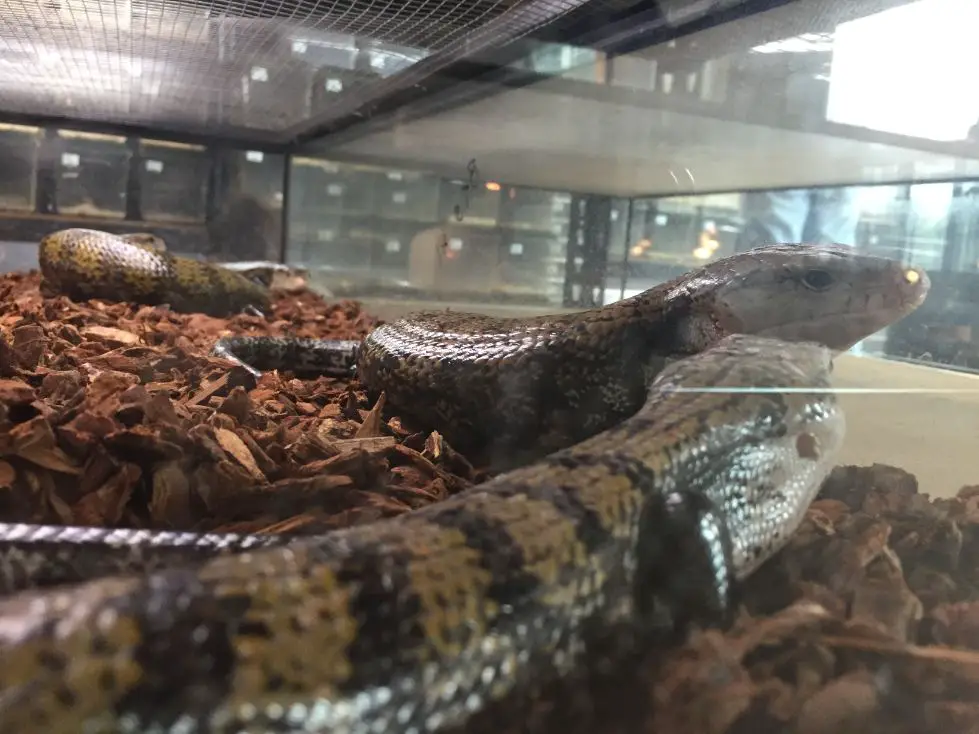
During the breeding season, the female releases a scent that attracts the male. Even so, the female is never willing to consent. Therefore, the male has to struggle before the female gives in.
Thus, female blue tongue skinks are usually aggressive towards the male during mating season. If the female is not ready to mate, she does not open her cloaca for the male to penetrate.
If she is not ready, she does not open her cloaca, and thus, the male eventually releases her.
Sometimes, the copulation duration can last for up to 6 hours. However, at this time, the male will be grasping the female, and intromission only occurs during the last minutes.
Blue tongue skinks males are not loyal to a single female. They will often try to mate with different females during the mating season. However, sometimes one blue tongue skink can copulate with the same blue tongue skink twice.
Immediately after copulation, the female’s abdomen undergoes a rhythmic contraction from posterior to anterior. Probably it’s due to the process of ovulation or the sperms moving to the reproductive tract.
However, it is worth noting that successful mating does not guarantee that the female will conceive. Males are reproductive active each year, while females only breed every 2-3 years.
How Old Does A Blue Skink Tongue Have To Be To Breed?
Blue tongue skinks start to breed once they reach a maturity age of 18 months to 2 years. Thus, producing a blue tongue skink before they are at least 18 months may be impossible.
However, some breeders argue that the size of the blue tongue skink matters more than the age. Some say that their blue tongue skinks were able to breed before they were even 18 months old.
Once blue tongue skinks get sexually mature or reach puberty age, they can breed. However, if it is underweight, it will have weak sperms which can affect sperm fertility. So, the blue tongue skinks should have standard weight when they get sexual maturation.
To get the best breeding results for your blue tongue skink in captivity, you should only try to breed them after they reach two years (24 months).
How Many Babies Does A Blue Tongue Skink Have At One Time?
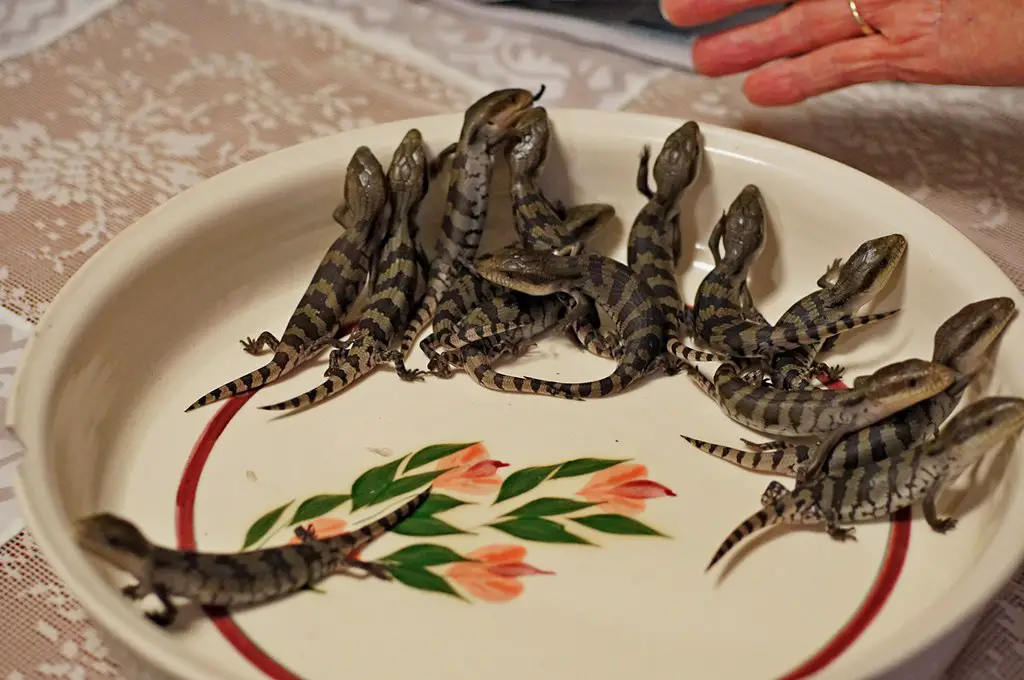
Unlike other lizards, blue tongue skinks are viviparous animals. Thus, they give birth to young ones rather than laying eggs.
Blue tongue skinks give birth 3-5 months after mating. A blue tongue skink can give birth to 10-15 babies in one reproductive cycle.
Therefore, you should be ready for 15 – 20 baby blue tongue skinks per cycle. Luckily, blue tongue skink babies are born active, and they can take care of themselves. Their first food after birth is the placenta and membrane.
However, you should be ready to provide a large tank and a balanced diet for better growth. Blue tongue skinks are antisocial. Thus, if you will house the babies together, make sure to include enough hideouts.
Do Blue Tongue Skinks Have a Breeding Season?
In the wild, blue tongue skinks have a breeding season. The breeding season can vary with the location of blue tongue skinks. For example, blue tongue skinks living in America may have a different breeding season than the skinks living in Asia. Usually, just after the brumation period.
However, in captivity, you can plan the mating season for your blue tongue skink. But, it is crucial if you would try to emulate the blue tongue skink natural cycle.
Before mating blue tongue skinks, you should prepare them for brumation. And, make sure to mate them just after brumation.
How to Breed Blue Tongue Skinks in Steps
Breeding blue tongue skink for the first-timers needs a lot of knowledge and understanding. Thus, there are several steps that you should follow before breeding your blue tongue skinks.
- Meet with a Breeder
Imagine starting a new career without training. You are likely to fail or give up even before you begin if you blindly jump into it without proper training.
The best person to give you proper training would be someone with experience. It is, therefore, critical to follow this step before you consider breeding bluetongue skinks.
- Learn about the blue tongue skinks lineages and genetic that you are about to breed
Like any other animal or human, remember that blue tongue skinks can carry their biological parents’ genes. Thus, performing a genetic analysis on both parents is essential to produce healthy blue tongue skinks.
Babies can inherit gene mutations from either of the parents. Thus, proper research on the parents will come in handy.
- Take your blue tongue skink to a vet.
It is necessary to take your blue tongue skink to a vet before breeding. The vet is responsible for making sure that your pet is healthy and fit to breed.
The vet should also perform a proper test to determine if there is any presence of viral infections in your blue tongue skink.
If you are not sure about the brumation process for your blue tongue skink, make sure to enquire from your pet vet.
- Prepare your Blue Tongue Skink for Brumation
Although it’s not compulsory for you to brumate your blue tongue skink in captivity, following their natural cycle is advisable.
Thus, you should consider allowing your blue tongue skink to brumate during the winter season.
After the brumation season, it’s usually the breeding season blue tongue skink. Thus, this will be the best time to introduce a male blue tongue skink to the female.
But, remember that blue tongue skinks are very aggressive when copulating. Thus, you should never leave them alone to mate. Sometimes they can fight to the death.
New to blue tongue skink? Check out the blue tongue skink care sheet now! We had listed out all the things you need to know about blue tongue skinks as pets. Check it now!
- Prepare Your Female Blue Tongue Skink With The Right Supplements
Diet is the most important thing in the breeding season for the blue tongue skinks. A healthy and nutritious diet ensures fertile semen with good motility.
Feeding your blue tongue skink with a proper diet is critical during the breeding season. Thus, it is essential to ensure that you add calcium and vitamin supplements in your blue tongue skink diet.
A proper diet will ensure that the blue tongue skinks are in good health during the breeding period.
- Prepare a Separate Breeding Tank
Blue tongue skinks are territorial animals that will aggressively fight for their space. Thus, you should consider putting them both in a new habitat during the breeding season.
It will help to reduce their aggression towards each other. Also, you should never put two males and one female in the same tank.
During the breeding season, ensure that the breeding tank is clean, and there is no possible substrate that can stick to the male hemipenes.
- Allow You Blue Tongue Skinks To Mate
After ensuring that you have your blue tongue skinks are healthy and fit to breed, it’s now time to let them mate.
Remember, sometimes the male might not show interest in the female. If this happens, remove it and introduce another male until you get the one that is ready to mate.
Also, in females, the female can sometimes be overly aggressive and refuse to open her cloaca for the male to penetrate. If the female is not receptive, take the male out and wait until the female is ready.
Also, the breeding process for blue tongue skinks is usually very aggressive, so you should supervise it.
If the breeding process is successful, it’s time to wait and observe if the female was able to conceive.
- Take Good Care Of The Pregnant Blue Tongue Skink
Before breeding your blue tongue skink, it is critical to measure her weight. Thai kỳ lưỡi xanh có trọng lượng tăng lên do sự phát triển của các nang trứng trong tử cung. If, after mating, she starts to get heavier, it’s just because she is pregnant.
Pregnant blue tongue skinks are usually aggressive and suffer from severe mood swings. Also, you will notice that it experiences short breaths. It is because the babies press her lungs, causing her breath to be slow.
During the pregnancy period, the blue tongue skinks require a lot of calcium and vitamin supplements. Also, you should increase the feeding times to at least once every two days.
It is necessary to ensure that your blue tongue skink has physical exercise to keep her in good shape.
- Set Up A Different Tank For Your Blue Tongue Skinks Babies
It is the last step in breeding blue tongue skinks. Babies are born small but intelligent enough to feed on their own without parent support.
Thus, you will have to separate them from their mother as soon as they are born. However, you will need to plan a good diet for the babies to be healthy.
How Long after Mating Does a Blue Tongue Skink Give Births?
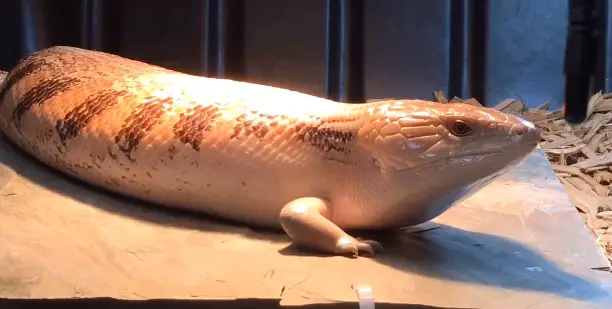
The breeding season for blue tongue skinks usually starts in late September all through November.
The blue tongue skinks start to give birth in late January all through February. Thus, the blue tongue skinks take approximately 3-6 months before giving birth.
Is my Female Blue Tongue Skink Laying Eggs?
Not at all! Your blue tongue skink can’t be laying eggs. Blue Tongue skinks are ovoviviparous. They develop eggs but they hatch inside the body. So, blue tongue skinks are not viviparous, because viviparous animals cannot develop eggs, their embryo develops into a fetus.
Sometimes blue tongue skink eggs can be fertilized, but they don’t form cotyledon. The blue tongue skink thus gives birth to slugs instead of living babies.
However, your blue tongue skink can give birth to live babies after producing slugs. If your blue tongue skinks keep producing slugs, you should consult a vet for proper diagnosis.
What to Remember When Taking Care of Baby Blue Tongue Skinks
Luckily, blue tongue skink babies are born intelligent and ready to take care of themselves. They are also hardy and can survive on any diet.
However, you should be ready to provide them with a proper diet to thrive in captivity.
Blue tongue skink diet comprises meat, vegetables, and fruits. Baby blue tongue skinks diet should have 70-80% meat, 20-30% vegetables, and 10% fruits.
Babies need lots of proteins to grow. Thus, it is crucial to ensure that you offer them proteins in large amounts.
Another thing to remember is to include enough substrate in the baby blue tongue skink tank. Blue tongue skinks are burrowing animals, and thus, the substrate should be at least 4-6” inches deep. The substrate should also be soft and loose.
The third thing to remember about taking care of baby blue tongue skink is temperature. Blue tongue skinks are cold-blooded animals. Thus, they require an ambient temperature to warm their bodies.
When the temperature is too low, the baby blue tongue skinks can refuse to eat. The required temperature for blue tongue skinks is 85-900 F.
Don’t forget to include UVB lighting in a baby blue tongue skink tank.
Conclusion
Breeding blue tongue skinks need a lot of patience. However, blue tongue skinks are hardy, and thus, they tend to thrive well in captivity.
Therefore, if you plan to start breeding blue tongue skinks, it’s worth every pain. However, you should be ready to design, invest, learn, and be patient before succeeding.
I am NOT a blue tongue skink breeder. Thus, the information in this article, while helpful, it’s not everything you need to know about breeding blue tongue skinks.
Thus, you should consider visiting a blue tongue skink breeder for an intensive breeding guide. However, if you have any questions about blue tongue skink, leave them in the comment section.
